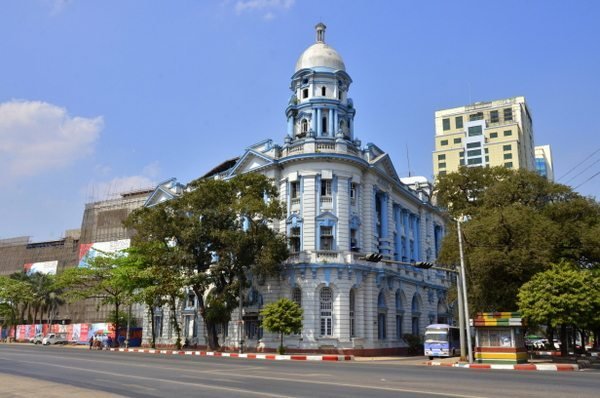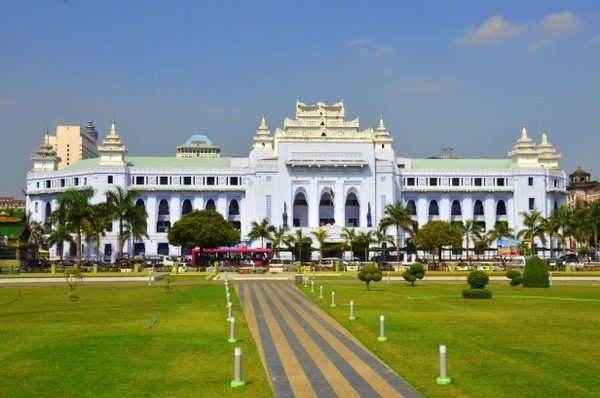Walking Through Yangon’s Colonial Past
Colonial Architecture in Yangon, Myanmar
I wander through the streets of Yangon, past men and women still wearing the traditional longyi, a wraparound skirt. In the murmur of a marketplace I hear the clanging of a bell but it’s a vendor spinning a large iron wheel then releasing it, its inertia pulling sugar cane through rollers extracting the sweet juice for a waiting customer. Buddhist monks wrapped in burgundy stroll with parasols in the midday heat. A woman on the sidewalk at a folding table with two battered telephones and some dubious wiring disappearing over the wall behind her sells phone calls. But what catches my eye is a semi-abandoned building across the street. No name or historical marker, but I know right away this dates from the early 20th century. And so does the building next to it, and the one beyond that. In fact, all around me I see the grandiose ghosts of colonial history.
On a sidewalk bookseller’s tarp lies a copy of National Geographic dated 1957. This is where Yangon is coming from. Think Havana, Cuba and its own tattered and dog-eared snapshot of the past. Yangon is a place that, for political reasons, got stuck in time and almost by accident preserved its past.
The British Empire took Yangon – calling it Rangoon – when they acquired Lower Burma in 1852 after the Second Anglo-Burmese War. At that time it was but a village with Sule Pagoda at its heart. Lt. Alexander Fraser, an army engineer, designed a European grid-style city around that pagoda. When the English took the rest of Burma in 1885, this city became not just the capital, but an important center for trade and finance in this corner of the Empire.
Soon after Burma’s independence in 1948, a coup installed an authoritarian and isolationist leader and the development of Yangon became frozen in time. Colonial buildings were spared the wrecking ball, but without maintenance, many have been deteriorating over the decades. And now, as Myanmar opens up politically, modern development threatens to bulldoze some of the survivors.
Recognizing this threat, the Yangon City Development Committee compiled a list of 189 public buildings that should be considered for preservation. The Yangon Heritage Trust (YHT), established in 2012, is working on a list that could expand that to nearly 2,000 when private buildings are also considered.
A walk along Strand and Merchant Roads, an area east of Sule Pagoda, is like a visit to an open-air museum: the Port Authority building with its Romanesque balustrades; the former Bank of Bengal Building with its charming tower and powder-blue trim; the Accountant-General’s Office and its red domes. A number of buildings were fortunate to have found new life with the funding to back it up. Oriental Life Assurance Building on Merchant Road has become the Indian Embassy. The 1900 J.F. Graham & Co. Building, former home of a shipping and insurance firm on Strand Road, now houses the British Embassy.
What was the Myanmar Immigration Office (until the Myanmar capital moved from Yangon in 2005), was originally a very popular department store, the Rowe & Co. Emporium. This 1910 structure, painted yellow with alternating red brick, stands out with its central tower at the street corner. Its stock of upscale imported goods are long gone; the halls empty and dust-filled. But a glimmer of panache remains and rumors are it has a future as a luxury hotel. The 1927 former New Law Courts building, a grand structure with its long colonnade and archways along the street, may also end up catering to visitors.
Going the hospitality route might not be a bad method of preservation. The Governor’s Residence, a 1920s mansion of teakwood, in what is now the embassy district, was reborn as a luxury hotel. So too The Strand Hotel has its colonial shine back on. The Sarkies Brothers, Persian-born Armenian siblings known for their luxury hotels in Southeast Asia, including the Raffles Hotel in Singapore, opened this Victorian-style hotel in 1901. The guestbook has seen the likes of Rudyard Kipling, Prince Edward, and Somerset Maugham. It fell into decay until renovations in the early 1990s restored and reopened it as a luxury-suite boutique hotel.
On a walkabout, I pass by another hefty brick building, the Railway Headquarters, built at the end of the 19th century. The grounds are rubble-strewn and grown in with weeds and trees. Once no doubt an impressive edifice, the red-brick building stands overlooking the tracks where local trains still rattle by. The windows are gaping black holes. Plans are in the works to create a five-star hotel, part of a complex of condos and high-rises with an estimated cost of $350 million dollars.
Some may cringe, but luxury and wealth were what made colonial Yangon to begin with. As the 20th century arrived, Burma had become an economic power. The son of Jewish migrants who came from Baghdad to settle in Burma, Isaac Sofaer made his fortune as an importer of luxury products. He hired Thomas Swales, a 20-something architect from England who had arrived via Singapore to start his own firm. Sofaer’s Building, on the corner where Merchant Street meets Pansodan, was a stunner. Today laundry hangs from some of the windows, but you can still visit an art gallery, take some milky tea, or even stay at a guesthouse within.
While the YHT is working with government to protect buildings, photographer Jacques Maudy and his partner Jimi Casaccia have sought to preserve them first in another fashion. They took photos of 87 historic buildings, as well as shots of the Burmese people and their life here in Yangon, and created a sixty-page coffee-table book, Yangon: A City to Rescue.
When asked which of the buildings is his favorite, Maudy will tell you: The Secretariat. Now the Ministers’ Building, it opened in 1902 as the center of administrative control for the British in Burma. Today it stands empty and decaying, a massive compound occupying a full city block. It had been off limits for many years, but Maudy was one of the first allowed inside. “The building had been closed to civilians to prevent the people from turning it into a shrine in remembrance of Aung San.” The liberator of Burma – and father to former political prisoner and Nobel Peace Prize winner, Aung San Suu Kyi – Aung San was assassinated here on July 19, 1947 with six others, just six months before independence came. “We were lucky to be the first to gain access and photograph the Victorian staircases, the massive courtyards, the red brick buildings, and the very room where Aung San was killed.”
It doesn’t take an architecture expert to see that many of these buildings vary in style beyond the Victorian. Art Deco and Neo-Classical elements stand out. The former High Court building represents the Queen Anne period. Furthermore, colonial-period architecture doesn’t just mean European styles brought in by the British. No one will mistake City Hall for a strictly Anglo design: The green peacock above the front entrance, the unusual columns, and the tiered roof details wouldn’t be out of place in a Burmese temple. Burmese architect U Tin designed this 1936 beauty. He also went on to design the railway station.
Daw Chaw Kalyar, the joint secretary of the Association of Myanmar Architects, refers me to the creation of a Burmese merchant, the son of Chinese immigrants. “The Chin Chong Palace is a rare and imposing building which demonstrates the blend of British and Myanmar architecture.” From the columns and balustrades out front rising up to the large central tower reminiscent of a Chinese pagoda, the lavish former home of Lim Chin Tsong dates back to 1918 and is now a state art school.
These historical treasures are easily found around the center of Yangon. Walking tours are growing in popularity, but it is important to find a guide who knows the history, the architects, and what’s notable about the designs. The Yangon Heritage Trust works with tourism authorities to provide guide training programs. If you’re heading to Myanmar, don’t forget your walking shoes.
Click here for a Yangon architecture photo gallery.










 ORDER YOUR COPY TODAY!
ORDER YOUR COPY TODAY! ORDER YOUR COPY TODAY!
ORDER YOUR COPY TODAY!
Pingback: Yangon Architecture Photos
It’s very beautiful. Glad that they still keep it that way 😉
Where can I get the images of the Chin Chong palace in the 90s?We are making a term paper for that palace and we can’t get the old photos of that palace
Dear Wendy
Contact Benny Lim in Canada. He is the great great grandson of Lim Chin Tsong. (erroneously pronounced as Ching Chong Palace) It’s actually Lim is surname and 1st & 2nd names were Chin Tsong (T is silent).
Benny’s Email address: borneo60@gmail.com ,
He has a website. Many photos.
Wendy, email me in regards to Chin Tsong palace.
borneo60@gmail.com or leave me your email, thanks
I live in Yangon and I’m very glad to read this article.
I’m also proud of myself to be a myanmar.